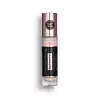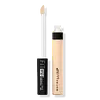Revolution Beauty Conceal & Define Infinite Longwear Concealer Versus Maybelline Fit Me Liquid Concealer
What's inside
What's inside
 Key Ingredients
Key Ingredients

 Benefits
Benefits

 Concerns
Concerns

 Ingredients Side-by-side
Ingredients Side-by-side

Water
Skin ConditioningIsododecane
EmollientCyclopentasiloxane
EmollientDimethicone
EmollientSilica
AbrasiveIsobutyl Methacrylate
Isohexadecane
EmollientButylene Glycol
HumectantEthylhexyl Palmitate
EmollientCetyl PEG/PPG-10/1 Dimethicone
EmulsifyingDimethicone Crosspolymer
Emulsion StabilisingQuaternium-90 Bentonite
Sodium Chloride
MaskingSorbitan Sesquioleate
EmulsifyingHydrogenated Castor Oil
EmollientPropylene Carbonate
SolventCaprylyl Glycol
EmollientMethicone
EmollientLecithin
EmollientPolyhydroxystearic Acid
EmulsifyingPentaerythrityl Tetra-Di-T-Butyl Hydroxyhydrocinnamate
AntioxidantPolyglyceryl-3 Polyricinoleate
EmulsifyingIsostearic Acid
CleansingIsopropyl Myristate
EmollientEuterpe Oleracea Sterols
Skin ConditioningPunica Granatum Seed Oil
EmollientNiacinamide
SmoothingTocopheryl Acetate
AntioxidantPhenoxyethanol
PreservativeWater, Isododecane, Cyclopentasiloxane, Dimethicone, Silica, Isobutyl Methacrylate, Isohexadecane, Butylene Glycol, Ethylhexyl Palmitate, Cetyl PEG/PPG-10/1 Dimethicone, Dimethicone Crosspolymer, Quaternium-90 Bentonite, Sodium Chloride, Sorbitan Sesquioleate, Hydrogenated Castor Oil, Propylene Carbonate, Caprylyl Glycol, Methicone, Lecithin, Polyhydroxystearic Acid, Pentaerythrityl Tetra-Di-T-Butyl Hydroxyhydrocinnamate, Polyglyceryl-3 Polyricinoleate, Isostearic Acid, Isopropyl Myristate, Euterpe Oleracea Sterols, Punica Granatum Seed Oil, Niacinamide, Tocopheryl Acetate, Phenoxyethanol
Water
Skin ConditioningCyclopentasiloxane
EmollientHydrogenated Polyisobutene
EmollientGlycerin
HumectantSorbitan Isostearate
EmulsifyingPropylene Glycol
HumectantTitanium Dioxide
Cosmetic ColorantOzokerite
Emulsion StabilisingPhenoxyethanol
PreservativeMagnesium Sulfate
Disteardimonium Hectorite
StabilisingDisodium Stearoyl Glutamate
CleansingMethylparaben
PreservativeAcrylates Crosspolymer
AbsorbentAlumina
AbrasiveButylparaben
MaskingAluminum Hydroxide
EmollientTocopherol
AntioxidantSilica
AbrasiveChamomilla Recutita Extract
Skin ConditioningCI 77891
Cosmetic ColorantIron Oxides
Mica
Cosmetic ColorantWater, Cyclopentasiloxane, Hydrogenated Polyisobutene, Glycerin, Sorbitan Isostearate, Propylene Glycol, Titanium Dioxide, Ozokerite, Phenoxyethanol, Magnesium Sulfate, Disteardimonium Hectorite, Disodium Stearoyl Glutamate, Methylparaben, Acrylates Crosspolymer, Alumina, Butylparaben, Aluminum Hydroxide, Tocopherol, Silica, Chamomilla Recutita Extract, CI 77891, Iron Oxides, Mica
 Reviews
Reviews

Ingredients Explained
These ingredients are found in both products.
Ingredients higher up in an ingredient list are typically present in a larger amount.
Cyclopentasiloxane, or D5, is a silicone used to improve texture of products and trap moisture.
D5 is considered lightweight and volatile. Volatile means it evaporates quickly after application. Once evaporated, D5 leaves a thin barrier that helps keep skin hydrated.
It is also an emollient. Emollients help soften the skin and prevent water loss. Silicones create a silky texture in products. D5 helps other ingredients become more spreadable.
Studies show D5 is safe to use in skincare products. We recommend speaking with a skincare professional if you have concerns.
Learn more about CyclopentasiloxanePhenoxyethanol is a preservative that has germicide, antimicrobial, and aromatic properties. Studies show that phenoxyethanol can prevent microbial growth. By itself, it has a scent that is similar to that of a rose.
It's often used in formulations along with Caprylyl Glycol to preserve the shelf life of products.
Silica, also known as silicon dioxide, is a naturally occurring mineral. It is used as a fine, spherical, and porous powder in cosmetics.
Though it has exfoliant properties, the function of silica varies depending on the product.
The unique structure of silica enhances the spreadability and adds smoothness, making it a great texture enhancer.
It is also used as an active carrier, emulsifier, and mattifier due to its ability to absorb excess oil.
In some products, tiny microneedles called spicules are made from silica or hydrolyzed sponge. When you rub them in, they lightly polish away dead skin layers and enhance the penetration of active ingredients.
Learn more about SilicaWater. It's the most common cosmetic ingredient of all. You'll usually see it at the top of ingredient lists, meaning that it makes up the largest part of the product.
So why is it so popular? Water most often acts as a solvent - this means that it helps dissolve other ingredients into the formulation.
You'll also recognize water as that liquid we all need to stay alive. If you see this, drink a glass of water. Stay hydrated!
Learn more about Water